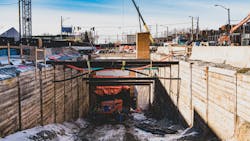Metrolinx’s Finch West LRT marks major milestone as big dig wraps up at Finch West Station
Metrolinx has finished digging out the new Finch West light-rail transit (LRT) station at Keele Stret and Finch Avenue West following 16 months of digging and hauling.
The Finch West Station will be the interchange between the Finch West LRT line and Toronto Transit Commission (TTC) Line 1 in northwest Toronto.
So, just how much earth had to be moved to create room for the station? About 65,000-cubic meters – enough to fill 26 Olympic-size swimming pools. All of that was trucked away by more than 8,000 dump trucks. That’s the culmination of nearly a year and a half of digging to reach 20 meters below ground at the site.
Safety and planning
Before the digging began, a lot of planning took place. The process began by clearing the area and setting up traffic control measures necessary due to heavy pedestrian and motor traffic at Finch Avenue West and Keele Street.
Once the coast was clear, heavy machinery was brought to the site including pile drivers, different sizes of excavators, bulldozers, track loaders and bobcats.
Safety and logistical planning then took place with engineers overseeing the installation of deep piles and heavy crossover supporting structures as the dig progressed to ensure the enormous cavern would remain stable and safe for the workers inside. As this work progressed, the machines and their operators worked together as a team to dig down and scrape out the contours of the station box, then deliver the dirt to a long-reach excavator which hauled it up to the surface.
“It was a mechanical chess match where dirt, grit, machinery and engineering meet to get the job done safely,” said Roberto Fernandez, Mosaic construction manager, stations and stops. “We are very excited to complete this huge milestone.”
But the logistics didn’t end when the soil was removed from the station box. Load after load of excavated earth was brought to surface level and loaded into dump trucks, then hauled to various approved registered disposal sites or other construction sites that require dirt fill.
“When the last dump truck left the site, the team took a moment to celebrate our achievement,” Fernandez said. “It was many months of hard work, but the team was relentless in their drive to get the job done quickly and safely. Now we move on to the next task.”
With excavation complete, the team is moving forward with structural work to build up the station, including pouring concrete to install the walls and concourse slabs.
